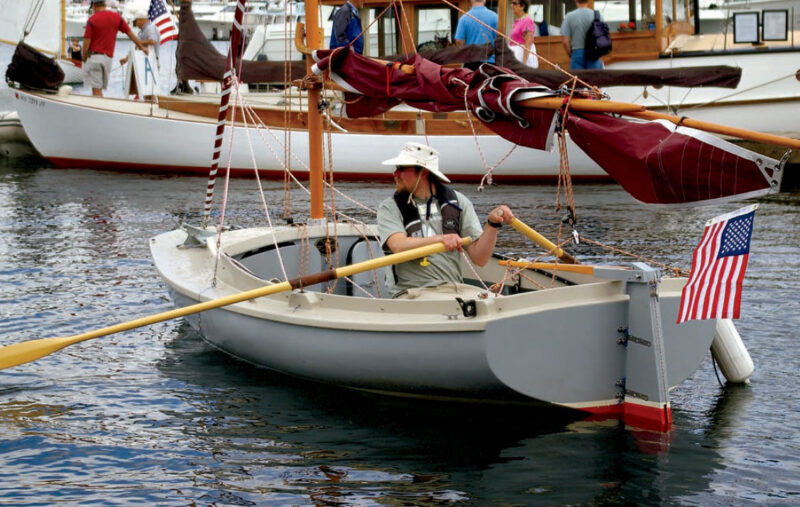 Cameron Kane
Cameron KaneThe author’s initial outings in his boat, ADVENTURE, were on Western rivers. In the summer of 2009, he plans an expedition along the Maine coast. The boat sleeps two and has ample dry stowage.
As my new boat, ADVENTURE, slid gracefully through the waters of Puget Sound, a light summer breeze off her starboard quarter, the many dollars and hours of labor I had expended over the past four years seemed like just so much flotsam on the stern wake trailing behind. Now it seems inevitable that I would have chosen this design, but it was not always so.
The great Pacific Northwest boat designer William Garden wrote in his book Yacht Designs II that “the right sort of boat that will make one happy is a nice sort of problem to have.” He’s right. But narrowing down one’s choices is still a problem.
I grew up on a 32′ carvel-planked wooden tugboat designed by Garden and named MAGGIE B, after my mother. So when I decided to build a boat myself, at least I had the designer in mind from the start. I discovered, however, that William Garden is one of the most prolific boat designers to ever live. While his 106′ brigantine design was not within my price range, there were still dozens of his boats that interested me. I decided to contact Mr. Garden, who is retired, for advice. He was very kind and encouraging. In order to narrow down my options, I stated the following requirements:
1. I live in Sioux City, Iowa, and that dictated a trailerable boat. I also needed a wooden boat that could withstand months out of the water.
2. The size of my garage and my finances dictated a small boat.
3. I liked the idea of learning to sail.
4. I wanted a boat that would make a good tender to MAGGIE B, but that could also hold her own camp-cruising for extended periods of time.
After reviewing a number of designs, I discovered the “Commodore Trunion Class 14′ x 6′ Sailing Pram” in Yacht Designs II. It had been designed as a daysailer for the purpose of teaching sailing to beginners. This pram was unlike anything I had ever seen before. The boat had a gunter-sloop sailing rig. A gunter rig, at first blush, looks like a typical marconi sloop. Closer inspection reveals rig details more akin to gaff configuration—but with a gaff so highly peaked as to be nearly vertical. The Trunion class’s mast was stepped forward, so it looked sort of like a catboat. It had great interior volume, and also looked as if it would move well through the water.
Garden had designed her to be round-bilged, built on plywood frames, and planked in 9⁄ 16″ cedar strips. Something just seized me about this design: stable, roomy, compact, safe, a good companion for MAGGIE B, and able to hold her own. I would give my new boat the name ADVENTURE, which seemed to me perfect for a boat designed for exploring rivers, backwaters, and coasts.
Of the time required to build this boat, Garden says “we missed by a mile our nod towards reasonable cost of building, this due to the amount of work involved in these one-off wooden boats.” Unfazed by this, in late spring 2005 I traveled back home to Washington state and quickly became the neighborhood sideshow as I built the construction jig, slowly traced the patterns for ADVENTURE’s frames from the loft floor, and mounted the frames on the jig. ADVENTURE’s frames were sawn from 3⁄4″ marine plywood, which was one of the easier jobs on her construction; the pram bow and transom, however, were a different story. The bow and transom are curved, raked, and wineglass-shaped. I had to build curved jigs and then laminate thin sheets of plywood over those jigs to get the desired shape. My dad then helped me place one thin cedar plank after the other, each one kissing the frames of plywood and the bow and transom, to enclose the hull.
Then I began the process of fairing the hull. I love my round-bilged boat, and she looks gorgeous, but one must be prepared for the agony of fairing to achieve such a thing. Just when I was sure I had the hull perfectly round, I was shown more hollows to be filled and bumps to be sanded down. After an entire summer of 10-hour days, all I had was a bare hull.
Garden’s original plans did not call for a deck, but with the approval of another designer, Paul Gartside, whom Bill Garden had recommended to me, ADVENTURE received a deck, coaming, and small cuddy cabin, all laminated out of 1⁄4″ marine ply. The deck presented more of a challenge than I had anticipated, due to its com-pound curvature. But it was well worth the effort: The deck and cuddy cabin keep water out in a chop, and provide dry storage space.
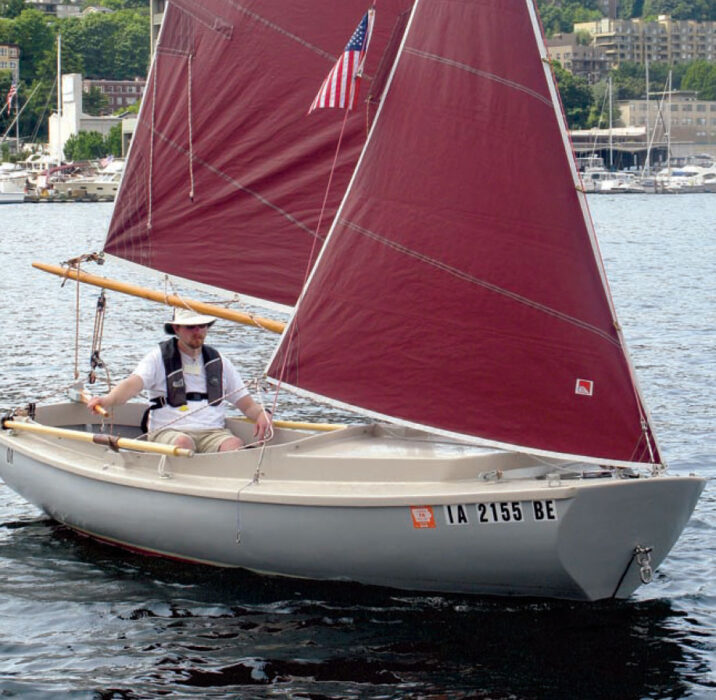 Cameron Kane
Cameron KaneBill Garden’s Commodore Trunion-class sloop is a 14′, pram-bowed daysailer of exceptional capacity. The author, with the assistance of designer Paul Gartside and approval of Bill Garden, modified the boat for camp-cruising by adding a deck and cuddy.
On July 29, 2007, with Douglas-fir spars stepped and carrying tanbark sails, ADVENTURE slipped off the trailer for the first time and into the cool green waters of Port Susan. The sound of water slapping against her hull and echoing throughout her bilge, after years of construction, told me like nothing else that I had done it: I had started out to build a round-bilged wooden boat from scratch and did it. MAGGIE B now had a little sister.
Despite a few hitches in her shake-down cruises, ADVENTURE has performed beautifully. Garden himself noted that the design was supposed to be stable, have fair performance under sail, and have enough buoyancy to float the crew if swamped. Thankfully I have never had to test that last one, but ADVENTURE is stable. She’s not a speed demon, but she is, as my sailor friend Steve Coyne says, “very well behaved.” She also goes well to windward, as proven during an outing on Lewis & Clark Lake in Yankton, South Dakota. The lake is long and narrow, and its winds are shifty. ADVENTURE, however, was responsive to alert steering, and she got us home.
Why go through all the trouble of the round bilge and curved, raked pram bow and transom? For one thing, these elements look cool. There are, however, more practical reasons for them. The March/April 2008 issue of WoodenBoat (No. 201) had a great article about hull forms. Although round-bilged boats are generally more difficult to build than flat-bottomed or V-bottomed ones, the article states that the shape of a round-bilged boat “responds to the undulations of water more gracefully than any other type of small boat.”
I reviewed a design for a Whitehall-style boat, and although this Whitehall was the same length as ADVENTURE, it had only about a 4′ maximum beam. I would roughly estimate that ADVENTURE has, with her pram bow, wide beam, and large transom, about three times the interior volume of that Whitehall. I packed her water-tight storage compartments full with clothes, blankets, air mattresses, tools, and cooking utensils, and still found plenty of room left over. She can comfortably sleep two and in a pinch can sleep three on the insert that converts her horseshoe-shaped seats into a big berth.
Garden acknowledged that the gunter rig is a complication; however, it is not without its compensations. The short spars make trailering easier because they can be stowed inside the boat, rather than on top of it, and the long sprit provides a great support for a tent.
ADVENTURE has auxiliary power in the form of oars and a small electric outboard motor, though she is happiest sailing. She loads fairly easily on a trailer, is not hard to beach, and fits into a standard 20′ x 10′ self-storage unit for the winter. She is, in short, a very capable, comfortable, and manageable camp-cruiser.
Plans for the Commodore Trunion Class Dinghy appear in the book Yacht Designs II, by William Garden (Mystic Seaport Museum, 1992).
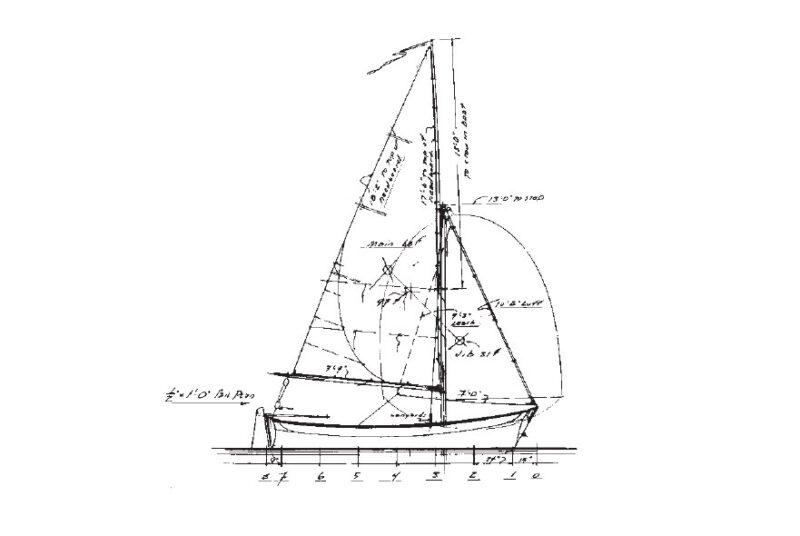 Bill Garden
Bill GardenBill Garden’s original drawings for the Commodore Trunion-class sloop show a surprisingly curvaceous little craft
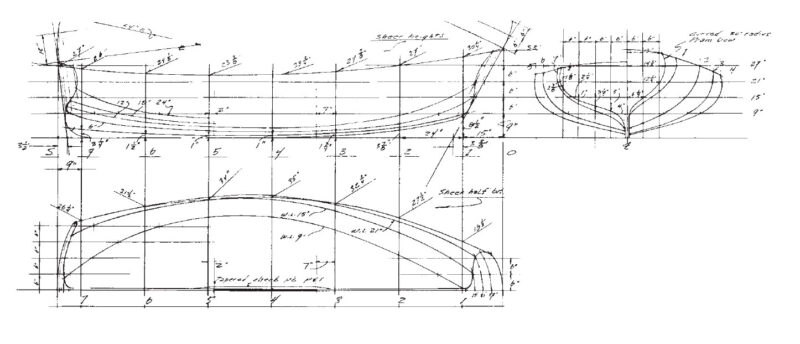 Bill Garden
Bill GardenThe spars of the gunter rig will stow easily inside the boat
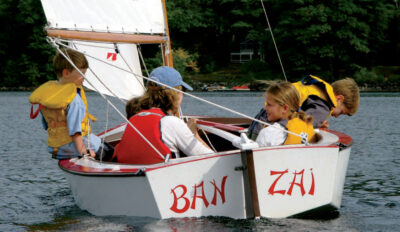
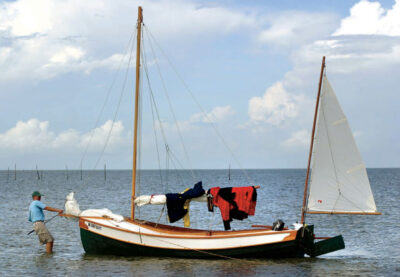
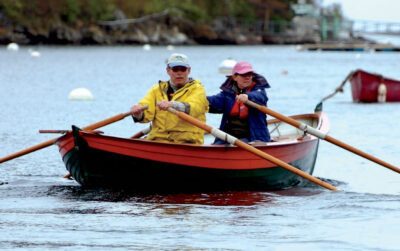
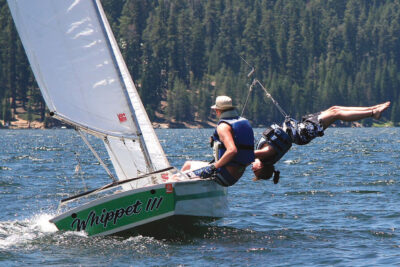
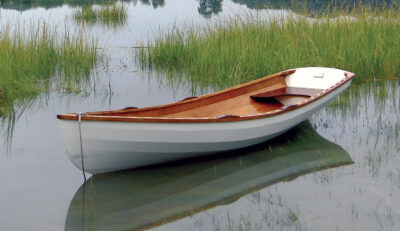
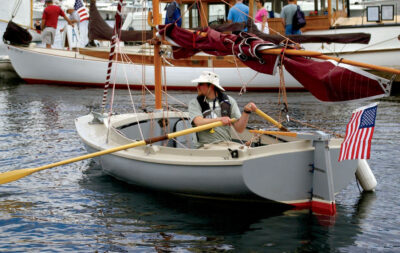
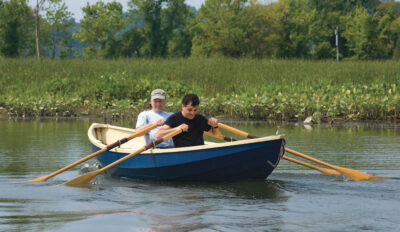
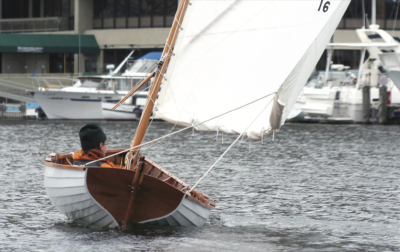
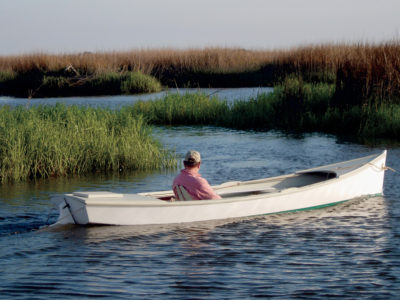
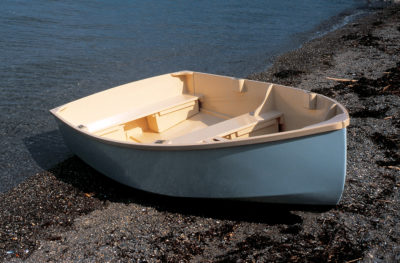


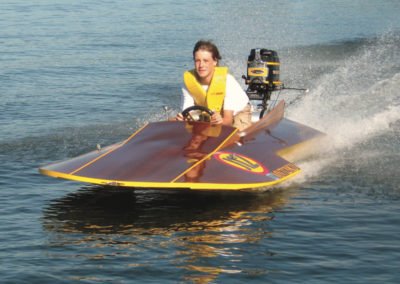
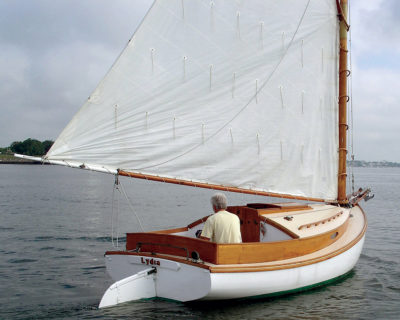
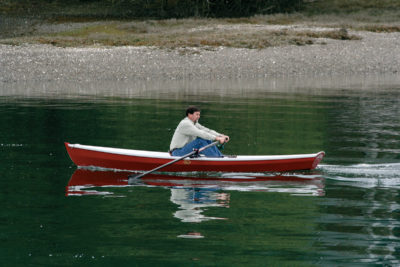
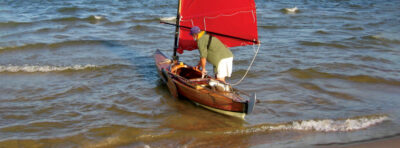
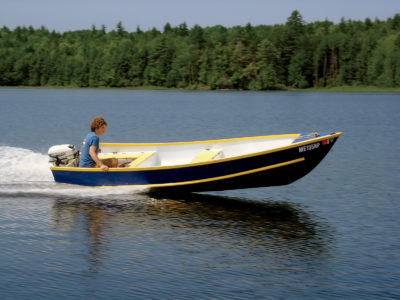
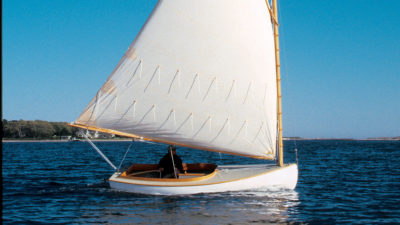
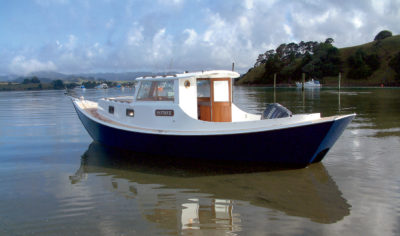

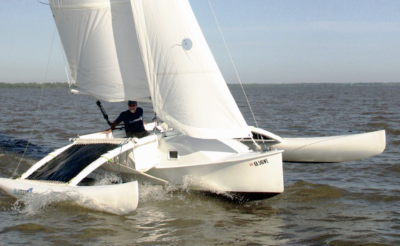
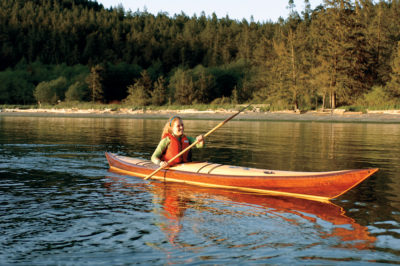
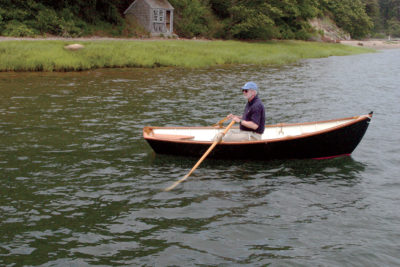
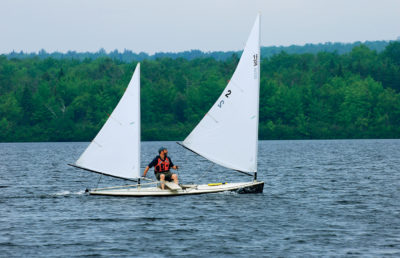
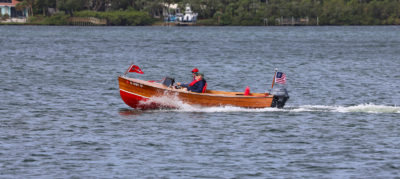
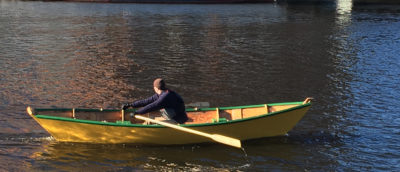
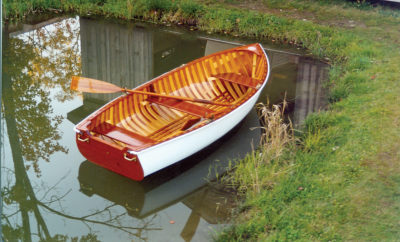
Excellent article well done. However, I am still trying to aesthetically accept the pram bow.
Another lovely boat from Garden’s drawing board. He is indeed a design wizard.